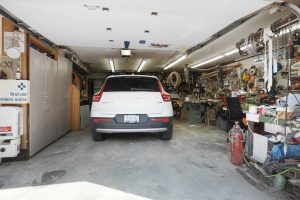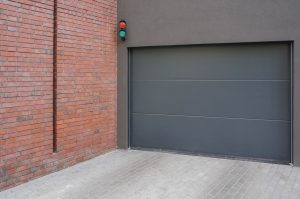Your garage door safety sensors are the invisible guardians that keep your family and belongings safe every day. But do you really know how they work or how to wire them correctly?
A simple mistake in the wiring can cause your sensors to fail, putting your safety at risk and your door out of operation. You’ll discover an easy-to-follow garage door safety sensor wiring diagram that anyone can understand. By the end, you’ll feel confident handling the wiring yourself or knowing exactly what to ask a professional.
Keep reading to protect what matters most and ensure your garage door works smoothly and safely every time.
How Garage Door Sensors Work
Garage door safety sensors stop the door from closing on objects. They detect obstacles and send signals to the door opener. This prevents accidents and damage.
The sensors work by creating an invisible beam across the door opening. When something blocks this beam, the door will stop or reverse.
How Infrared Sensors Create A Safety Beam
Two sensors face each other on either side of the door. One sensor sends an infrared light beam. The other sensor receives this beam.
As long as the beam is clear, the door can close. If the beam breaks, the sensors tell the door opener to stop closing.
Wiring Connections Between Sensors And Door Opener
Sensors connect to the door opener with low-voltage wires. These wires carry signals to and from the sensors.
The wiring must be secure to avoid false signals or sensor failure. Proper wiring ensures the sensors work every time.
Power Supply And Signal Transmission
The sensors get power from the door opener unit. This power runs through the sensor wires.
Signal transmission happens instantly when the beam is blocked. This quick response keeps people and pets safe.
Common Types Of Sensors
Understanding the common types of garage door safety sensors helps you choose the right setup for your home. These sensors protect you, your family, and your belongings by stopping the door from closing if something is in the way. Knowing how each sensor works can save you from costly repairs and potential injuries.
Photoelectric Sensors
Photoelectric sensors use a beam of light to detect objects in the path of the garage door. If the beam is broken, the door automatically reverses or stops closing. These sensors are popular because they are reliable and easy to install.
Have you ever noticed how the door stops when a pet or child crosses the threshold? That’s the photoelectric sensor at work, keeping everyone safe.
Pressure Sensors
Pressure sensors detect resistance when the garage door hits an object. These are usually installed on the bottom edge of the door. If the door meets an obstacle, the sensor triggers the door to reverse immediately.
These sensors are especially useful in busy garages where objects might be left on the floor. They add a layer of protection by sensing direct contact, not just a broken beam.
Infrared Sensors
Infrared sensors emit invisible rays that detect motion or heat near the door. When something passes through the sensor’s range, it sends a signal to stop or reverse the door. This technology is often used alongside photoelectric sensors for extra safety.
Imagine pulling your car into the garage and the door stops if a person suddenly appears. Infrared sensors provide that quick reaction to unexpected movement.
Magnetic Sensors
Magnetic sensors use magnets to detect whether the door is fully closed or open. They don’t detect obstacles but ensure the door operates correctly by monitoring its position. These sensors are crucial for alerting you if the door isn’t properly sealed.
Have you ever wondered why your garage door won’t close all the way? A faulty magnetic sensor could be the reason, signaling a misalignment or obstruction.
Tools And Materials Needed
Before you start wiring your garage door safety sensors, gathering the right tools and materials is essential. Having everything ready not only saves time but also makes the installation smoother and safer. Missing a critical tool midway can lead to frustration and potential errors.
Essential Tools For Wiring Garage Door Safety Sensors
- Wire Strippers:These help you remove the insulation from the wires without damaging the metal inside.
- Screwdrivers:Both flathead and Phillips screwdrivers are useful for mounting sensors and securing connections.
- Multimeter:This tool checks electrical continuity and voltage, ensuring your sensors receive power correctly.
- Drill with Bits:Sometimes you need to drill holes to mount sensor brackets or route wiring neatly.
- Electrical Tape:Use this to protect wire connections and prevent short circuits.
- Wire Connectors or Butt Splices:These ensure strong and safe wire joins.
- Ladder:A sturdy ladder helps you reach high places safely during installation.
Materials You’ll Need For The Wiring Setup
- Garage Door Safety Sensors:Choose sensors compatible with your garage door opener model.
- Low-Voltage Wire:Typically 18-22 gauge, this wire connects the sensors to the opener’s control panel.
- Mounting Brackets and Screws:These secure the sensors in place at the correct height and angle.
- Cable Clips or Staples:Use these to neatly fasten wires along the door frame and walls.
- Wire Labels or Markers:Labeling wires during installation helps avoid confusion later.
Have you ever started a project only to realize halfway that you’re missing a crucial tool? That’s why preparing your workspace with these items is a smart move. What’s your experience with wiring—do you prefer having everything on hand or figuring things out as you go?
Preparing For Installation
Preparing for the installation of garage door safety sensors is crucial. Proper setup prevents accidents and ensures smooth operation. Before starting, gather all tools and materials needed for the job. Review the wiring diagram carefully to understand the connections.
Clear the installation area to avoid any obstacles. This makes the process safer and faster. Take time to study the sensor parts and their functions. Knowing each component helps avoid mistakes during wiring.
Inspecting The Sensors
Check the sensor lenses for dirt or damage. Clean them gently using a soft cloth. Damaged sensors can cause false signals or failure. Make sure the mounting brackets are intact and sturdy. Loose brackets may misalign sensors, affecting performance.
Confirm that the sensor lights turn on when powered. This shows the sensors are receiving electricity. Replace any sensor that does not light up or looks broken.
Checking The Wiring
Examine all wires for cuts, frays, or corrosion. Damaged wiring can create shorts or signal loss. Use a wire stripper to remove insulation carefully, avoiding wire damage. Match wires to the diagram colors and labels exactly.
Test wire continuity with a multimeter to ensure no breaks exist. Secure wires away from moving parts and sharp edges. Proper wire routing prevents accidental disconnections and wear over time.
Wiring The Sensors
Wiring the sensors is a key part of installing garage door safety systems. Proper wiring ensures the sensors work correctly to prevent accidents. This section explains how to connect and secure the sensor wires safely and effectively. Clear steps help avoid wiring errors and maintain system reliability.
Connecting The Wires
Begin by identifying the sensor wires by color and function. Typically, sensors have two or four wires. Match the wires from the sensor to the corresponding wires on the garage door opener unit. Use the manufacturer’s wiring diagram as a guide. Strip about half an inch of insulation from each wire end. Twist the matching wires together tightly. Avoid loose or exposed wire connections to prevent shorts or signal loss.
Securing The Connections
After twisting the wires, cover each joint with a wire nut. Twist the nut firmly until it feels secure. Wrap the wire nut and exposed wire with electrical tape for extra protection. Use zip ties or clips to fasten the wires neatly along the door frame. Keep wires away from moving parts to avoid damage. Properly secured connections reduce the chance of disconnections or electrical hazards.
Testing The Sensors
Testing the sensors is a vital step in ensuring garage door safety. Sensors detect obstacles and prevent accidents by stopping the door from closing. Regular testing keeps the system reliable and protects people and property.
Aligning The Sensors
Proper alignment is key for sensors to work correctly. Both sensors must face each other directly. Check the mounting brackets to ensure they are steady and not loose.
- Look for the LED lights on each sensor. A steady light usually means proper alignment.
- If the light blinks or is off, adjust the sensors slowly until the light stays solid.
- Use a level tool to confirm sensors are straight and even.
- Clear any dirt or debris from the sensor lenses for a clear signal.
Performing Safety Tests
Safety tests confirm that the sensors stop the door when needed. Place an object, like a box, in the door’s path. Try closing the door using the remote or wall switch.
- The door should reverse immediately when the sensor detects the object.
- If the door does not stop, check sensor wiring and connections.
- Test multiple times to ensure consistent sensor response.
- Keep the sensor wiring away from power cables to avoid interference.
Regular safety tests prevent accidents and keep your garage door system working smoothly.
Troubleshooting Common Issues
Check the wiring connections carefully when your garage door safety sensor stops working. Loose or damaged wires often cause sensor errors. Following a clear wiring diagram helps fix common problems quickly and keeps the door operating safely.
Garage door safety sensors play a crucial role in protecting your family. They ensure the door stops and reverses if it detects an obstruction. Over time, issues can arise, affecting the sensor’s performance. Understanding common problems can help you fix them easily. Below are two major issues and their troubleshooting tips.Sensor Misalignment
Misaligned sensors are a common reason garage doors stop working properly. Safety sensors must face each other for proper operation. Even a slight movement can disrupt their alignment. To fix this issue:- Check if both sensors point directly at each other.
- Ensure the LED lights on both sensors are on and steady.
- If one or both lights are blinking, adjust their positions gently.
- Use a level tool to confirm both sensors are perfectly aligned.
Faulty Wiring
Worn or damaged wiring can interrupt the signal between sensors. This can cause the door to malfunction or fail to close. Over time, wires can fray or become disconnected due to wear. To troubleshoot wiring issues:- Inspect the wires connected to each sensor for visible damage.
- Check for loose connections or dislodged wires at the sensor terminals.
- Secure any loose wires and replace damaged ones with new ones.
- Ensure the wires are not pinched or tangled during the repair process.
Maintenance Tips
Garage door safety sensors play a crucial role in keeping your home safe. But without proper maintenance, these sensors may fail to work as intended. Regular upkeep ensures they operate smoothly and prevent accidents. Let’s dive into some practical tips to help you maintain your garage door safety sensor wiring diagram.
Inspect Wiring Regularly
Examine the wiring for visible damage or wear. Broken or frayed wires can disrupt the sensor’s performance. If you notice any issues, replace the damaged wires immediately. Keeping the wiring intact is essential for consistent functionality.
Clean The Sensors
Dirt and debris can obstruct the sensors, causing them to malfunction. Use a soft cloth to gently clean the sensor lenses. Avoid harsh chemicals that might damage the surface. A clean sensor ensures accurate signal transmission.
Check Sensor Alignment
Misaligned sensors can prevent the garage door from closing properly. Use a level to ensure both sensors face each other and are at the same height. Adjust them carefully until the alignment is perfect.
Tighten Loose Connections
Loose wiring connections can lead to intermittent issues. Check all connections in the wiring diagram, especially at junction points. Secure loose connections to maintain a stable electrical flow.
Test Sensor Functionality
Periodically test the sensors to ensure they’re working correctly. Place an object in the sensor’s path and try closing the garage door. If the door reverses, the sensors are functioning as intended. If not, troubleshoot or consult a professional.
Replace Worn Components
Over time, certain components may wear out. Inspect the wiring diagram and replace any outdated parts, such as connectors or mounts. Keeping the parts fresh extends the lifespan of your sensors.
Secure The Wiring
Loose or hanging wires can easily get damaged. Use zip ties or cable clips to secure the wiring along the walls or ceiling. Organized wiring not only looks neat but also prevents accidental damage.
Schedule Professional Maintenance
While DIY maintenance is great, professional inspections can catch hidden issues. Hire a technician to review your sensor wiring diagram annually. Their expertise can ensure everything works flawlessly.
Frequently Asked Questions
What Is A Garage Door Safety Sensor Wiring Diagram?
A garage door safety sensor wiring diagram shows how sensors connect to the opener. It ensures proper installation and functionality. This diagram helps identify wiring paths, sensor placement, and connections. It is essential for troubleshooting and maintaining safety features in automatic garage doors.
How Do Garage Door Safety Sensors Work?
Garage door safety sensors emit an infrared beam to detect obstructions. When the beam is interrupted, the door stops closing. This prevents accidents and ensures safety. Sensors are typically mounted near the floor on both sides of the door.
Can I Install Safety Sensors Without A Wiring Diagram?
Installing safety sensors without a wiring diagram is risky. A diagram ensures proper connections and prevents errors. Incorrect wiring can lead to malfunction or safety issues. Always use the manufacturer’s diagram for guidance.
Why Are My Garage Door Sensors Not Working?
Garage door sensors may stop working due to misalignment, wiring issues, or dirt. Check alignment and clean the lenses. Ensure the wiring is intact and connections are secure. If problems persist, consult the wiring diagram or a professional technician.
Conclusion
Proper wiring of garage door safety sensors keeps your home secure. It prevents accidents by stopping the door from closing on objects or people. Follow the wiring diagram carefully for correct installation. Check connections regularly to ensure sensors work well.
Simple steps can protect your family and property. Stay safe by understanding how sensors function and connect. This knowledge helps avoid costly repairs and injuries. Trust the process, and keep your garage door reliable every day.








